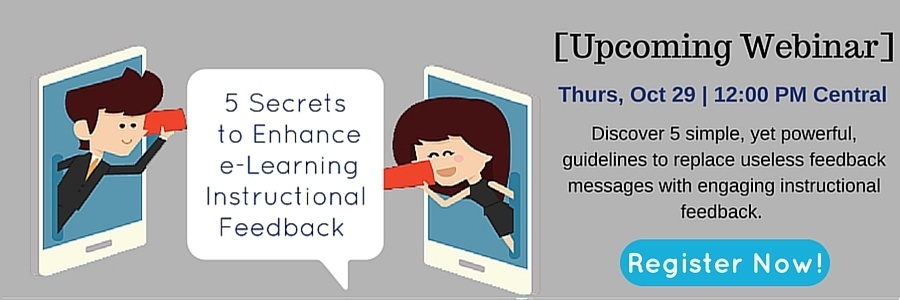Blog
What Are Your Top e-Learning Design & Development Challenges?
By Richard Sites, Vice President - Training & Marketing | @rhillsites A few months ago, I posted a blog asking all of you to share the critical ...


You Asked. We Listened: Your Top e-Learning Design & Development Challenges
By Richard Sites | October 20, 2015 | Custom Learning | 0 Comments
By Richard Sites, Vice President - Training & Marketing | @rhillsites
.png?width=125&name=Sites%2c_Richard_(New).png) A few months ago, I posted a blog asking all of you to share the critical challenges you often face when designing and developing e-Learning.
A few months ago, I posted a blog asking all of you to share the critical challenges you often face when designing and developing e-Learning.
Our team of bloggers here at Allen Interactions have collaborated and provided advice, guidance and tips to help you manage these challenges.

Challenge:
People who want to see a finished product 5 minutes after they have given you their PowerPoint slides! Also out of date materials is a real big issue for me. - Dave B.
Response:
Yes, it is frustrating to be pushed to deliver something without adequate time to prepare. I think the larger issue is being thought of as simply someone who puts PowerPoint slides online. All of us need to take ourselves seriously as Instructional Designers and show our clients and SMEs that we do more than convert slides. We can add value by creating realistic context for learners and by trying to create interactive experiences that replicate real-world challenges that learners will face on the job. We can let our clients know that it takes time to be creative, but that it will be worth the wait.
Out of date content is an issue we struggle with, too. The only strategy I’ve found that works is to set a “frozen” date. That means that after 5:00 PM on a specific date, content changes will no longer be accepted. The content is frozen as of that time and development will proceed. Does that prohibit all future changes? I wish! But, it does encourage SMEs to be more responsible for making content changes early in the project. It also gives you a way to talk about the importance of creating e-learning with something that isn’t a moving target. Also, depending on your business model, it will give you the basis for a “change order” to reflect the impact on timeline and budget of content changes if those come late in the project.
- Linda Rening, PhD, Senior Instructional Designer
Challenge:
Project deadline set by a project coordinator before an instructional designer performs analysis and scope. - Jenny J.
Response:
If the project deadline is set before an instructional designer gets involved and can establish reasonable expectations, and the deadlines are inflexible (in reality, they are often inflexible for unimportant reasons, but whatever), the ugly truth is that the instructional designer must work within existing parameters. That’s all you can do. You have to inform your client that “You cannot expect a reasonable degree of success because we did not do real audience analysis and had to cut user testing...but it’s done. It’s ugly...but we do whatever we can do based within the timeframe.
-Edmond Manning, Senior Instructional Strategist
Challenge:
Everyone thinking they are instructional designers because they taught a class once. - Anne
Response:
I taught four unique classes for ATD. The skills required to facilitate a full classroom are much different from those of an instructional designer. It’s like comparing the skills of a person who designs cars to someone who drives cars professionally. Only people who understand neither world make that comparison.
-Edmond Manning, Senior Instructional Strategist
Challenge:
Stakeholders who want a particular feature in an e-learning course they saw once on a website, with no acceptance of what the authoring tools can/can't do. - Andy
Response:
One of my favorite phrases is ‘Conflict is a problem wrapped in emotion.’ The problem is the authoring tool won’t do what they want. That’s easy to solve: adopt a different authoring tool. But if that solution isn’t available, then you have a conflict—the stubborn refusal to accept these limitations. Approach this as a conflict, not a problem. Something emotional is going on. Why do they refuse to accept reality? What is the root of their frustration? Is the problem that they want highly interactive learning and they aren’t seeing it? You can create interactive learning with a PowerPoint document, so don’t blame the authoring tool. My point is...you have to investigate (listening skills and quiet patience) what the true emotional root of this conflict is if you hope to solve the problem.
-Edmond Manning, Senior Instructional Strategist
I think the answer to that challenge lies in taking the focus off the development tool, and focusing on the learner. Specifically, focus on the behavioral objectives for the learner. Start with the question, “What do you want learners to be able to DO when they have completed this training course?”
Once you’ve identified 4 or 5 observable behaviors you want learners to perform, then you can talk about media and methodologies to teach the knowledge and skills that are the underpinnings for those behaviors. Lead the discussion away from gimmicks and tricks, and toward what is best for learners to become proficient in new behaviors.
Ethan Edwards always says there is a perfect time to use Jeopardy or Monopoly games in e-learning: when you are training contestants for Jeopardy or Monopoly games. Form needs to follow function in learning. That means the e-learning should, as much as possible, look and feel like the actual environment in which learners will have to perform.
- Linda Rening, PhD, Senior Instructional Designer
Challenge:
One of my biggest challenges in design and development is SMEs not having or getting a Trainer/Adult Learner education. Many have difficulty understanding training development needs. -Lawrence S.
Response:
Personally, I wouldn’t want SMEs involved in the design of my training. I think the problem is that in their role of SME they get to influence how you design training. Instead of trying to upskill them in adult learner education, you could focus on getting them OUT of the design process and into the feedback process. If you absolutely can’t extricate them from your design process, consider bringing ATD onsite to conduct a one-day class for your SMEs on adult learning theory. Corral them all in one room to hear the message of how people learn.
-Edmond Manning, Senior Instructional Strategist
Challenge:
Management desire numbers. They will settle for statistics on how many people are trained time spent in training. They really prove that training is improving some outcome, but that is hard to obtain. -Kathleen L.
Response:
“Yes, it’s hard to obtain because so few companies are doing it! If you’re looking for proof of performance improvement, focus your attention on call centers. They track tons of variables: lengths of calls, whether someone offered the right upsell, if the right lines were used, etc. Because they are tracking Level 4 variables (impacts to the business) and isolating them by performance, you’re more likely to find performance-oriented training and examples from a call center. Mind you, they aren’t the ONLY ones doing performance-oriented training...but not a lot of businesses recognize that tracking employee performance is the only way to tell if you’re getting the results you want.
-Edmond Manning, Senior Instructional Strategist
Thank you for sharing your top e-Learning design & development challenges with us! Were the responses to these challenges helpful? Let us know!
LIKE WHAT YOU'VE READ? CLICK HERE TO SHARE THE KNOWLEDGE WITH THIS READY-MADE TWEET!
CLICK TO TWEET: You Asked. We Listened: Your Top #eLearning Design & Development Challenges http://ctt.ec/hoI99+ #aiblog

About the Author: Richard Sites
Comments
Would you like to leave a comment?
Related Blog Posts

By: Richard Sites | Aug, 2015
Category: Custom Learning

Blog
Youthful e-Learning Design
By Richard Sites, Vice President - Training & Marketing | @rhillsites A few months ago, I posted a blog asking all of you to share the critical ...
By: Richard Sites | Nov, 2012
Category: Custom Learning

Blog
Four e-Learning Design Practices to Leave Behind
By Richard Sites, Vice President - Training & Marketing | @rhillsites A few months ago, I posted a blog asking all of you to share the critical ...
By: Richard Sites | Oct, 2013
Category: Custom Learning, Strategic Consulting


